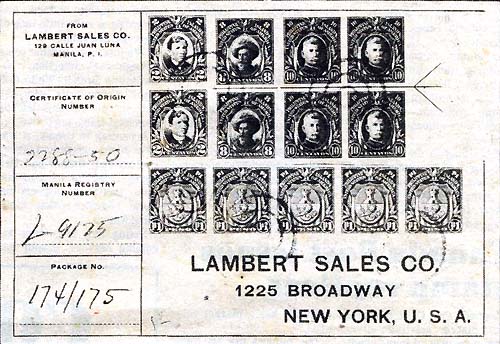
Lambert Sales Co. labels such as this one
are virtually the only sources
of used copies of the scarce Philippine imperforate
issues of 1925.
The label shown here is one of the beautiful exceptions.
It bears a horizontal strip of five 1p imperforate stamps, a right margin
arrow block of four of the l0c, and vertical pairs of the 2c and 8c, the
latter with a horizontal guideline.
The listings for these stamps in the Scott catalogs
are curious indeed. Volume 1 of the Scott Standard Postage Stamp Catalogue
identifies an imperforate printing of 1925-31, but lists, prices and identifies
colors only for the later 1931 reprints. The much more numerous imperforate
reprints were produced six years after the original Lambert Sales Co. order
was filled, to meet the demand of incensed collectors who had been unable
to get copies for their albums.
Though too few collectors original are aware of
it, these 1931 reprints differ on many points from the original imperforate
stamps. While the differences in color — and in value — are spelled out
in the Scott Specialized Catalogue of United States Stamps, the treatment
given the 1925 issues is most unusual. The 1931 reprints have Scott catalog
numbers (340-53); the original issues do not. Instead, they appear to be
listed as color varieties of the reprints, though they have no numbers
of their own. There can be few if any other instances
in which reprints receive full catalog status and the original stamps
are denied it as such.
As laid out in the table, the most obvious difference
between the 1925 issues and the, later reprints is color: The former exhibit
shades many Philippines collectors have never seen. Most often the 1931
reprints are found in even many of the most advanced Philippines collections.
Most dealers will admit that they do not know the difference, because neither
set comes into most stamp firms often enough to make proper comparisons.
On mint sets, the gum is a major difference between
the 1925 and the 1931 stamps. The 1931 issue has diagonally lined, or swirled
gum, while the 1925 issue is generally smooth by comparison. Paper thickness
and tone also vary between the two. The 1931 was printed on a thicker,
more yellowish paper, while the 1925 imperforates are on a thinner, whiter
paper. The vivid colors used for the 1925 stamps, however, are the"" most
reliable difference between the two sets. The extremely short production
run of the 1925 imperf orates al-lowed the BEP to take greater care in
their printing, and the results are striking in shade and appearance.
It is estimated that 80 percent of the total postal
value of the 1925 issue was used by the Lambert Sales Co. to send registered
packages from the Philippines to the United States between June 22 and
Oct. 26, 1925. The last known package shipment date recorded is Oct. 21.
The company found handling imperforate stamps
in a major shipping operation to be extremely inconvenient, and discontinued
their use.
For the collector, acquiring the 2c to 8c denominations
of the 1925 imperforate issue is relatively easy. The l0c to 30c middle
values are more difficult, notwithstanding their fairly modest catalog
values. With fewer than a thousand of each issue, and a mere 200 copies
of the 4p and lOp, the four peso denominations in the set are a genuine
challenge mint or used.
One of the most rewarding and enjoyable ways to
collect all of these stamps is tied to the Lambert Sales Co. labels with
registry datestamps and related shipping information. Full labels with
sound stamps are most desirable and most elusive. Similarly, labels with
dated cancellations are scarce and sought after.
An exceptional exhibit of the 1925 imperforates
and Lambert Sales Co. labels will be displayed during the annual WESTPEX
show in San Francisco, Calif., from April 29 to May 1.
|

